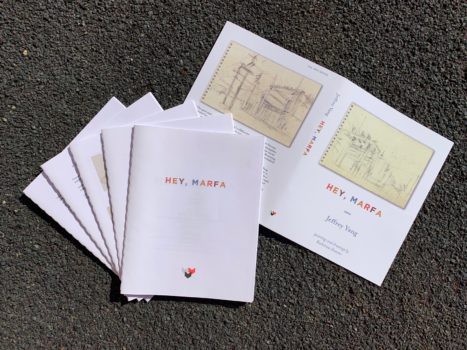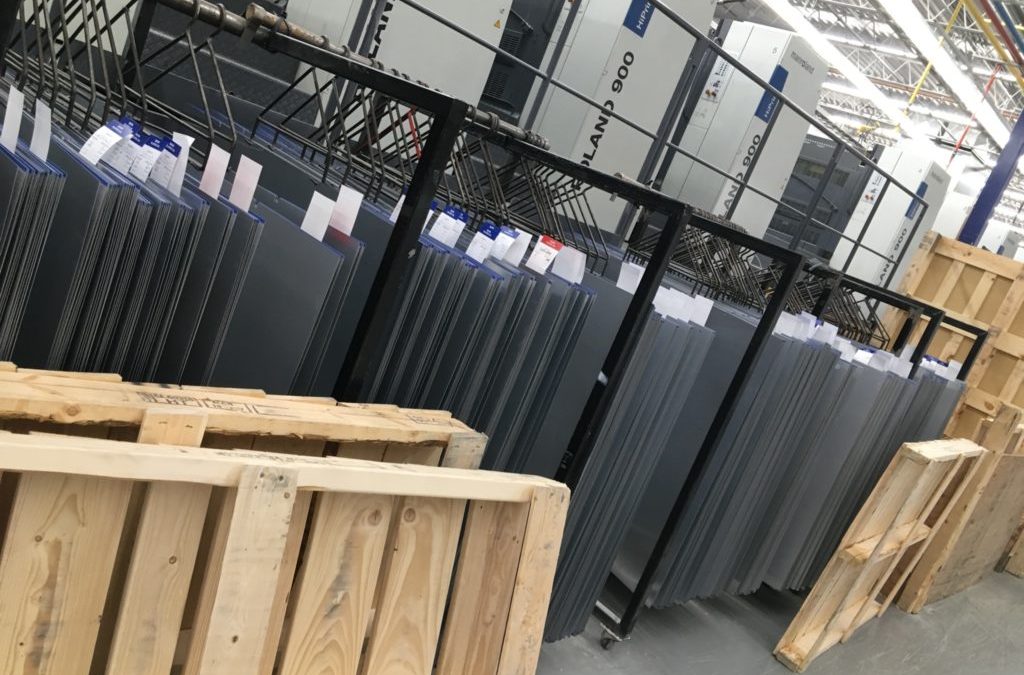Bookmobile is a short run digital printer, but our design and typesetting department works with and manages offset printing with outside vendors. Printing offset is a completely different printing process than digital printing. Offset printing is great for higher quantity books or more complex titles that require lots of specialty elements. The proofing process for offset printing, however, is a bit more complex.
The reason for the complexity lies in the process. Offset printing is the “old school” method of book printing. Without getting overly technical, the gist is: Once a book is approved to start printing, the content gets etched onto large “plates” (see above image). These plates are inserted into the offset printing machine, along with the ink and paper, and as the machine runs the plates make light impressions on the paper—creating your printed page. Once an offset press gets going, they are very fast—printing, trimming, and collating all at one time. Because of an offset press’s speed, it’s not very cost effective to set up the press just for a printed proof, not to mention it is time consuming for press operators.
So, what are your options if proofing on press isn’t viable at an offset printer?
The first proofing stage in offset printing is prepress proofs. Prepress is everything that happens before your book actually starts printing on press.
There are two proofs we require for every offset job and are always bundled into the base cost of your quote:
- Interior softproof, a PDF of the interior after the file has gone through the printer’s preflight software.
- Color contract proof of the cover, a high-res, hard copy proof of the cover with color simulation on proofing paper and printed on a digital machine.
Additional (and optional) prepress proofs that can be helpful to see include:
- Color contract proof of printed endsheets, a high-res, hard copy proof of your printed (black or 4-color) endsheets, printed from a digital machine on proofing paper. This type of proof only applies if your book is a hardcover with printed endsheets.
- Content proof of the interior, a hard copy of the interior of your book to proof for content. It’s printed to size, however it’s not color accurate and images (if any) will appear low resolution, so it’s not meant to evaluate quality.
- Per-page color contract interior proofs, a high-res, hard copy proof of an individual page (not spread) with color simulation on proofing paper and printed on a digital machine. You can order however many interior pages you want, but since these are charged per page, printing a lot of pages can get very expensive. This proof is not applicable for some projects.
Because color contract proofs are printed from a digital machine on proofing paper, there can be color variation when the book is printed offset on its final paper.
As soon as you give your approval on these prepress proofs, the offset printer will start printing all copies. During the prepress stage is the time to make any last minute corrections; it will be costly later on if there are changes you want to make.
After your book has printed on press, you can opt to see postpress proofs. Postpress proofs are pulled from the main run of books, after all copies have been printed, so it’s exactly what the final product will look like. The only difference is that postpress proofs are not yet bound together. We call these proofs “components.”

F&Gs and a finished cover for a Graywolf Press book.
- F&Gs, which stands for “folded and gathered” signatures. This is the complete and final interior, unbound. F&Gs are useful to confirm you are happy with the printing and that specs and materials are accurate.
- Finished covers/DJs/cases/endsheets, these components are exactly what they sound like. Your book’s cover will have lamination and any specialty elements (like foil stamps, spot gloss, and the like) applied.
Once you’ve given us your approval on these components, the printer will bind all copies.
The last optional proofing stage is seeing a book advance (typically between 1-5 copies). A book advance is the final book all bound up; these are sent for approval before the bulk quantity ships. In the rare instance there is an issue with the final copies, the printer is better equipped to handle the problem if all books are still at their facility.
What costs are associated with offset proofs?
The interior softproof and color contract proof of the cover are always included in the base cost of your offset quote. All of the other proofs listed are add-on costs and are completely optional. In most cases, there is a cost for actually producing the proof itself. Then, proofs for approval ship via next day air, so it can get spendy if you order every proof listed and need them shipped to multiple people. We make every effort to bundle proofs where possible to help lessen the costs of shipping.
We recommend letting us know which proofs you want to order and where they will be shipped to, so that we can update the quote and get a more accurate sense of the overall cost.
What happens if you find a mistake during these proofing stages?
If the mistake was your own, such as a typo or design flaw, you will need to pay to have it fixed. Making a change to the book during the prepress stage is a lot more cost effective than later on. Most printers charge a flat fee to repreflight a cover file and then a per-page rate for interior page corrections. If you require another set of hard copy prepress proofs, expect to pay for them twice.
If you find a mistake at the postpress stage (or even in an advance copy), you will need to pay to have the file repreflighted, replated, and reprinted. Most publishers evaluate whether or not fixing the mistake is worth the added cost and delay to the schedule. Ultimately, it is your decision.
If the mistake is one the printer has made (such as applying the wrong cover lamination), they will fix the mistake at no additional cost to you.
Does seeing additional proofs affect the schedule?
Typically no. Most printers can accommodate the same turnaround time even if you order every single proof that’s available. However, this largely depends on you—how quickly you are able to approve proofs, whether or not you have corrections, and at what stage in the process corrections are needed.
If you are on a tight deadline, it’s advisable to skip some of these proof stages, as the printer may then be able to turn around books faster.
Questions? Contact us!

